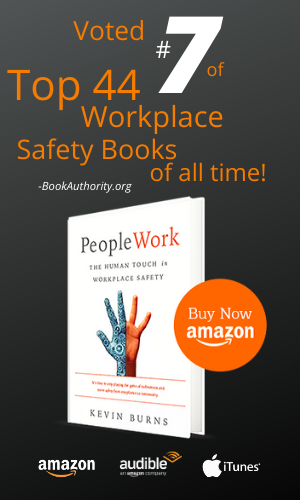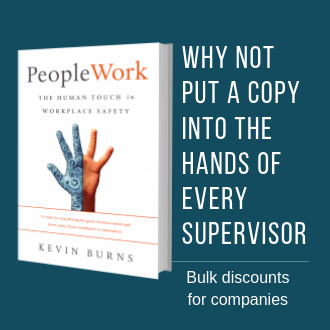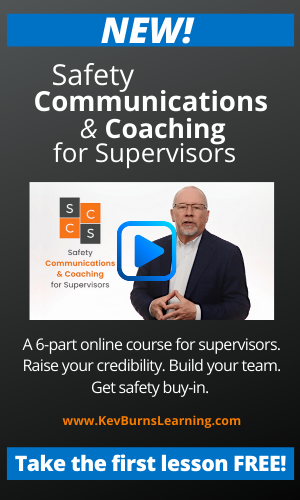Are You Talking About These 4 Things in Safety Meetings Yet?
If you want better participation and engagement at safety meetings, then there are four things you should be talking about at your meetings. Are you talking about them yet?
Safety meetings are a legal requirement. However, making your meetings boring is not required by law. That is voluntary. Although there are some required points of discussion in meetings, there is no law preventing you from using your meetings to motivate and engage your people. Nor is there a law preventing having fun and opportunities to speak-up in the meetings. It’s not in the safety code. I looked it up. So, are you going to continue the endless bullet-point assault or are you willing to try something better?
Focus on engagement, not checkboxes.
Here’s what’s not better: safety meeting templates. Companies actually sell these templates where you just plug in your own stats, procedures, reviews and your “reminders of the week.” These cookie-cutter templates have been dumbed down to try to appeal to as many industries as possible. This creates meetings that are bland, ordinary and focused on checking boxes; not inspiring teamwork. Meanwhile, as the meeting leaders cover their own behinds, they do it at the cost of numbing the minds of their people with text-laden PowerPoint slides that fail to create safety buy-in or to own the hearts and minds of employees.
Safety meetings are not supposed to solely focus on rules, procedures, processes, inspections and incidents. Meetings are also supposed to create better engagement and conversation around safety. To create a stronger bond between team members in having them want to look out for each other. Meetings with the sole purpose of checking boxes does nothing to build inspiration and motivation in your team.
To build inspiration and motivation you need effective communications and coaching. That's what you will learn in the Safety Communications & Coaching for Supervisors course. You can start by taking the Free Preview: 40-minutes of video instruction, summary sheet download PDFs and a companion MP3 audio version to take with you on the go. And it's free to get started.
Are you getting buy-in to your game plan?
 Imagine a professional sports team whose pre-game meeting just before the big championship game was focused on reviewing rules, inspections and paperwork. And then, for good measure, throw in a story of how a former team failed in their pursuit (think about it ... that's exactly what many safety meetings are focused on ... failures and injury). Reviewing past failures does nothing to inspire motivation and engagement. No smart thinking team would ever make the focus of their pre-game meeting all about how they failed in their bid to win the big game. If it doesn’t help to create a championship team mindset, why do it in your safety meeting?
Imagine a professional sports team whose pre-game meeting just before the big championship game was focused on reviewing rules, inspections and paperwork. And then, for good measure, throw in a story of how a former team failed in their pursuit (think about it ... that's exactly what many safety meetings are focused on ... failures and injury). Reviewing past failures does nothing to inspire motivation and engagement. No smart thinking team would ever make the focus of their pre-game meeting all about how they failed in their bid to win the big game. If it doesn’t help to create a championship team mindset, why do it in your safety meeting?
Safety meetings aren’t just to focus on rules. If you’re a professional, you should already know the rules. And you had better know the rules if you’re making a living at what it is you're doing. To build better safety performers you have to use your meetings to help improve a worker’s ability, their motivation and their focus. Harping on rules does little of that.
So if you want better buy-in and engagement in the safety program, here are 4 things you should be talking about in safety meetings:
Accountability
Every worker has an obligation to be responsible for his/her actions. Getting your people to move from tolerating rules to an “I've got this” ownership mindset doesn’t happen without accountability. Accountability does not involve blame. Finding someone else to blame for an incident or action means that you don’t embrace accountability as a personal value. “I could have done more” is easier to forgive than trying to one-up allegations of blame and finger-pointing.
Teamwork
Solid-performing teams are more willing to help compensate for each other. Find a player out of position on a sports team and you’ll find someone else willing to momentarily jump in and fill that spot until the original player can get back into position. Good teams know when a fellow player is out of position, needs some back-up, needs to get their head back in the game or maybe needs a time-out. And good teams make it happen. Get your people working in small crews where, over time, they get to know each other’s moves, their habits and their strengths. Over time, they will begin to find way to compensate for any weaknesses or inefficiencies within their own team. Small crews have less tendency to turn over staff than large crews. It’s comforting to know your crewmates have your back.
Respect
 Although self-respect is the cornerstone of any safe workplace, it isn’t all of it. Respect for your teammates is equally as important as respect for yourself. You cannot give that which you do not own. So, if you have no self-respect, you cannot give respect to others. A workplace lacking in respect is a dangerous workplace. When you demonstrate respect, you demonstrate caring. It is so much easier to demonstrate respect for people you care about than people you don’t. That’s why solid-performing teams have a healthy respect for each other as both workmates and people.
Although self-respect is the cornerstone of any safe workplace, it isn’t all of it. Respect for your teammates is equally as important as respect for yourself. You cannot give that which you do not own. So, if you have no self-respect, you cannot give respect to others. A workplace lacking in respect is a dangerous workplace. When you demonstrate respect, you demonstrate caring. It is so much easier to demonstrate respect for people you care about than people you don’t. That’s why solid-performing teams have a healthy respect for each other as both workmates and people.
Courtesy
Courtesy is a major contributor to any good safety program and what drives positive actions on the job site. Courtesy is a preventative measure - a thing you do without being told. Courtesy is demonstrated on the way to work with other employees; in the parking lot by parking unselfishly, in the lunch room by cleaning up after yourself, and on the job site by not being a nuisance or distraction. Never is courtesy the reason that someone gets hurt or puts someone else at unnecessary risk. One of the best ways to demonstrate courtesy is by speaking up on the job site and in safety meetings.
When people become accountable for their actions, when they feel more like a valuable part of the team, when they demonstrate respect and courtesy in their actions, they will be more than willing to speak up in safety - especially in safety meetings. When people engage in the safety meeting, buy-in to safety is imminent.
-- Take the FREE preview lesson of Kevin's course Safety Communications & Coaching for Supervisors. 40-minutes of video instruction, summary download PDFs and a companion audio MP3 version to take with you on the go. SCCS is an online course to help energize safety, build teamwork, and get employee buy-in.
Take the FREE preview lesson of Kevin's course Safety Communications & Coaching for Supervisors. 40-minutes of video instruction, summary download PDFs and a companion audio MP3 version to take with you on the go. SCCS is an online course to help energize safety, build teamwork, and get employee buy-in.
Kevin Burns, consultant/author, works with smart, caring companies to energize safety culture, build teamwork, and get employee buy-in. KevBurns Learning is committed to to helping companies improve safety by improving people, through creative learning materials, virtual strategy sessions, safety meeting presentations, and team coaching programs.
In 2020, BookAuthority.org named PeopleWork #7 of The Top 44 Workplace Safety Books of All Time. Buy yourself a copy of PeopleWork: The Human Touch in Workplace Safety and give another as a gift to a colleague.
Subscribe to Kevin's YouTube channel.
Subscribe to Kevin’s Blog.


